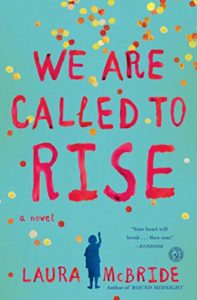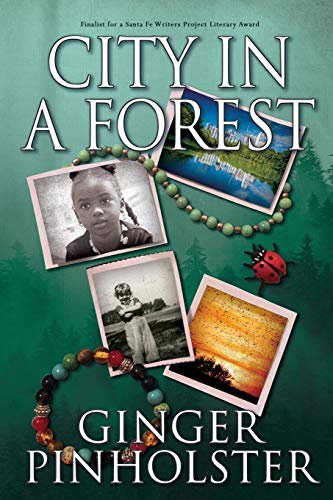City in a Forest received a 4+ star review, making it an IndieReader Approved title.
Following find an interview with author Ginger Pinholster.
What is the name of the book and when was it published?
City in a Forest. The book’s release date was set for Sept. 19, 2019.
What’s the book’s first line?
“On her breezy aquamarine porch, Arden ran a thumb over the letter’s sinister return address, which featured an amateurish sketch of two crossed nails, reminding her of the county’s plan to crucify her.”
What’s the book about? Give us the “pitch”.
Hidden in the heart of Atlanta, a pristine forest shimmers with magic, but an unscrupulous developer plans to flatten Silver Park – unless two brave women can stop him. Arden Collier risks losing her home. Parker Gozer owns most of Arden’s secret forest, which is rooted in Atlanta’s rich African-American history. As Arden struggles to reclaim her artistic voice, Parker confronts the man who once preyed upon her – and now wants to spoil a rare urban oasis. Both women fight to protect the place that has tangled itself around their hearts like flowering kudzu vines, achingly sweet as a beloved child.
What inspired you to write the book? A particular person? An event?
Arden and Parker’s story was inspired by my experiences growing up in Atlanta in the 1970s. Atlanta was the fastest-growing urban settlement on the planet at that time and the tree canopy kept shrinking. I lived near a fascinating African-American community, tucked into the woods. In writing my book, I imagined what would happen if a pristine forest had somehow escaped destruction, deep within one of those hidden neighborhoods – many of which were unfairly seized. I had to face the imbalance between all I’ve been given and those who don’t have a voice in protecting their most cherished places.
What’s the main reason someone should really read this book?
My goal, with City in a Forest, was to provide readers with an experience that’s both immersive and emotional. I wanted readers to imagine being surrounded by a cherished place of natural wonders with vivid colors, smells and sensations. In the book, my character Parker longs to return to Silver Park, a beloved place from her childhood. She imagines herself “in another world and time, bright green with moss-covered trees,” by a waterfall where trees annually turn “red, purple, and yellow, shaking in the spray.” Becoming attached to beloved places is part of the human experience. These may not be the places where we receive mail and earn a living, but they provide a home for our hearts and our imagination. In reading City in a Forest, I hope that readers will be transported to the magical landscapes they hold dear.
What’s the most distinctive thing about the main character? Who-real or fictional-would you say the character reminds you of?
Arden Collier, a once-famous Atlanta artist who is grieving the end of her marriage, creates brilliantly emotive African dikenga figures, and her garden features an enchanting glass menagerie, yet inside her house, she is hoarding pointless possessions, trying to hang onto the past.
Parker Gozer, my second strong female protagonist in City in a Forest, is a sought-after publicist who knows how to “make it rain” at work, but struggles to set any work-life limits and aches to return to a simpler time and place.
If they made your book into a movie, who would you like to see play the main character(s)?
In my dreams, Viola Davis, the first woman of color to win the “Triple Crown of Acting” – an Academy Award, Emmy Award, and Tony Award – would play Arden Collier. Reese Witherspoon, also a major award winner who broke my heart in the film version of Cheryl Strayed’s Wild, could be tapped to play Parker Gozer.
When did you first decide to become an author?
Becoming an author was never a conscious decision; I have to write, just as I have to eat, sleep, and search for sea turtle nests in my spare time. I wrote my first short story, entitled “The Ghost of Rock Mountain,” when I was six or seven years old. A ghost was terrorizing the town. Different townspeople kept going up to Rock Mountain to combat the ghost, but each time, they disappeared, one by one – until a brave, clever girl finally scared the ghost off. This story was likely derivative of various books in the Nancy Drew mystery series, which I loved to read as a kid.
Is this the first book you’ve written?
When I was an undergraduate at Eckerd College, my senior thesis was a probably-terrible collection of short stories called Sunspots. I also briefly toyed with a thriller called Orion! The Hunter. City in a Forest was my first attempt to write a book of literary fiction. I’ve now completed a second novel, Angel-Dog Finds Me, and I’m very excited about a third book – a love story about mental illness and stigma called Seeing Gethin.
What do you do for work when you’re not writing?
I write about science and technology for a university in Daytona Beach, Florida.
How much time do you generally spend on your writing?
Not nearly enough. My day job has a tendency to get in the way of my creative writing, but I usually manage to squeeze in 4-6 hours over the weekend and maybe another 3-4 hours during the week, after work hours.
What’s the best and the hardest part of being an indie?
The best part of being an indie author is the direct access that I’ve had with my publisher, Black Rose Writing. Whenever I have a question about the publishing process, I can easily get a speedy answer. The most difficult aspect of being affiliated with a small independent publisher is that it can feel like an uphill battle, getting bookstores to take my work seriously.
What’s a great piece of advice that you can share with fellow indie authors?
Writing is hard work, but remember to have fun with it, too. Close your office door and read your work aloud. Act out the dialogue. Immerse yourself into the world you’re creating on the page. Writer Anne Lamott wrote, in Bird by Bird, that “the first draft is the child’s draft, where you let it all pour out and then let it romp all over the place, knowing that no one is going to see it and that you can shape it later.” Allowing your imagination to have play time is a great privilege – enjoy it. Once your first draft is complete, then you can unleash your inner grownup and revise your work.
Would you go traditional if a publisher came calling? If so, why?
I would always be grateful for any credible publishing offer. My first experience has so far been positive and a wonderful learning opportunity.
Is there something in particular that motivates you?
I want to tell my truths, to unleash my stories into the world in hopes that readers might share the same human experiences. Then they will know they’re not alone. I sincerely believe that, through the simple act of reading, we make the world a better place.
Which writer, living or dead, do you most admire?

Which book do you wish you could have written?
We Are Called to Rise, by Laura McBride.

